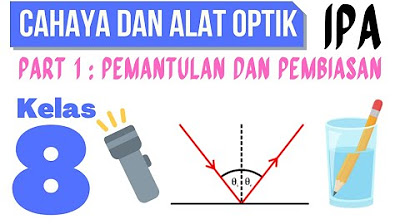2nde - La réfraction
Summary
TLDRThis optics course on light refraction explains how light travels in straight lines within homogeneous media and how its speed changes in different materials, defined by the refractive index. Visibility is contingent on light reaching the observer's eye. Through engaging examples and a practical experiment with a submerged coin, the phenomenon of refraction is demonstrated. Snell's law is introduced, linking the angles of incidence and refraction to the refractive indices of the involved media. This exploration of light behavior not only illustrates fundamental optical principles but also invites curiosity about the science behind everyday observations.
Takeaways
- 😀 Light travels in straight lines in a homogeneous medium, defined by consistent properties like density and temperature.
- 🌟 For an object to be visible, light from that object must reach the observer's eye.
- 🚀 The speed of light in a vacuum is about 3 x 10^8 m/s, but it decreases in other transparent media.
- 🔍 The refractive index (N) quantifies how much light slows down in a medium compared to a vacuum; it is always greater than or equal to 1.
- 💧 Common examples of refraction include the bending of a straw in water and the distortion of objects viewed through transparent materials.
- 🔬 A practical experiment involves adding water to a bowl to make a submerged coin visible, demonstrating light refraction.
- 📐 Snell's Law mathematically relates the angles of incidence and refraction to the refractive indices of two media: N1 sin(θ1) = N2 sin(θ2).
- 📏 The angles in Snell's Law should be measured carefully, with attention to the units used (degrees vs. radians).
- 🧪 When light crosses from one medium to another, its direction changes at the interface, which can lead to surprising visual effects.
- 👩🔬 The lecture encourages further exploration of scientific concepts and experiments related to light and optics.
Q & A
What is the fundamental behavior of light in a homogeneous medium?
-Light travels in a straight line in a homogeneous medium, where properties like composition, density, and temperature are uniform throughout.
What is necessary for an object to be visible?
-For an object to be visible, light emitted or reflected from that object must reach the observer's eye.
How is the speed of light characterized in different media?
-The speed of light, or its 'celerity', is approximately 3 x 10^8 m/s in a vacuum, but it decreases in other transparent media like water or glass.
What does the index of refraction represent?
-The index of refraction (N) is a dimensionless number that indicates how much light slows down in a medium compared to its speed in a vacuum; it is always greater than or equal to 1.
Can you give examples of the index of refraction for common materials?
-For water, the index is about 1.3; for glass, it is approximately 1.5; and for air or vacuum, it is 1.
What is the phenomenon of refraction?
-Refraction occurs when light changes direction as it passes from one medium to another, such as when observing a straw in a glass of water, which appears bent.
How does the 'normal' relate to the incident and refracted rays?
-The 'normal' is an imaginary line perpendicular to the interface (dioptre) between two media, and the angles of incidence and refraction are measured from this line.
What is Snell's Law?
-Snell's Law mathematically relates the angles of incidence and refraction to the indices of refraction of the two media: N1 * sin(angle of incidence) = N2 * sin(angle of refraction).
What happens to a ray of light that strikes the interface perpendicularly?
-A ray of light that strikes the interface perpendicularly does not change direction; it continues straight through the interface.
Why does adding water to a bowl make a coin at the bottom visible?
-Adding water changes the medium, allowing the light from the coin to refract and reach the observer's eye, making the coin appear visible.
Outlines

This section is available to paid users only. Please upgrade to access this part.
Upgrade NowMindmap

This section is available to paid users only. Please upgrade to access this part.
Upgrade NowKeywords

This section is available to paid users only. Please upgrade to access this part.
Upgrade NowHighlights

This section is available to paid users only. Please upgrade to access this part.
Upgrade NowTranscripts

This section is available to paid users only. Please upgrade to access this part.
Upgrade NowBrowse More Related Video

CAHAYA DAN ALAT OPTIK (PART 1) : IPA KELAS 8 SMP

Basic Optical Laws - Reflection - Refraction - Snells Law

Refração da luz: Índice de refração absoluto. 1/4

Refração da luz: Lei de Snell. 2/4

Physics for Engineers | Lesson 15.2 | Propagation of Light I

REFRAÇÃO DA LUZ E DISPERSÃO LUMINOSA - ÓPTICA - Aula 8 - Prof Boaro
5.0 / 5 (0 votes)